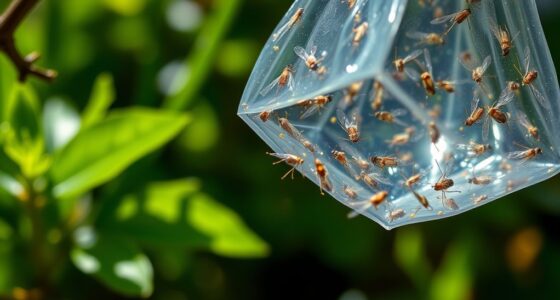In temperate climates, pests emerge in spring from dormant eggs or pupae, making early intervention effective. As temperatures rise in late spring and early summer, you’ll see increased activity from mosquitoes, flies, and beetles, with populations peaking. Summer sees rapid reproduction and overlapping generations, so timely control is essential. In fall, pests seek shelter indoors, while in late fall or early spring, populations decline but can rebound. Continuing will help you understand how to manage these stages effectively.
Key Takeaways
- Spring sees pests emerging from dormancy, with early-stage eggs and larvae vulnerable to preventive treatments.
- Late spring to early summer marks peak pest activity, requiring regular monitoring and early interventions.
- Summer features overlapping pest generations, making integrated pest management critical for control.
- Fall focuses on sealing entry points and removing attractants as pests seek indoor shelter and activity declines.
- Transition periods in late fall and early spring involve monitoring and prevention to reduce re-emergence of pests.

Understanding when pests are most active can help you better protect your home and garden throughout the year. Being aware of their pest lifecycle allows you to anticipate their behavior and plan your control timing effectively. Pests don’t show up randomly; they follow specific patterns tied to seasonal changes, which means recognizing these patterns can considerably reduce infestations.
Knowing pest activity patterns helps you time control efforts and prevent infestations effectively.
In early spring, many pests emerge from their dormant stages, often as eggs or pupae, waiting for warmer weather. You might notice ants starting to forage or early signs of aphids on new plant growth. During this period, pests are in the initial stages of their lifecycle, making it an ideal time to intervene before populations grow. Targeting pests now with preventive measures, such as applying treatments or removing breeding sites, can prevent bigger problems later. Since pest control is most effective when pests are in their vulnerable stages, understanding their lifecycle helps you time your efforts precisely.
As temperatures rise in late spring and early summer, pests become more active and reproduce rapidly. You’ll see increased activity from mosquitoes, flies, and beetles, which are in their adult stages now. This is when many pests reach peak activity, so control timing becomes essential. Regular monitoring and early intervention during this window can curb their populations before they become overwhelming. For example, applying insecticides or setting traps at this stage can be highly effective because pests are more exposed and less protected.
Summer months often see the highest pest activity, especially for those with multiple generations per season. This is when pests are in full reproductive swing, and their lifecycle stages are overlapping. If you wait too long to act, you risk infestations spiraling out of control. Recognizing these phases allows you to implement integrated pest management strategies, such as biological controls or targeted chemical treatments, timed to when pests are most susceptible. Proper control timing during this period helps you break the pest lifecycle and reduce future populations.
Come fall, many pests begin to decline as temperatures drop. However, some, like rodents and certain overwintering insects, seek shelter indoors. Knowing this, your pest control efforts should shift toward sealing entry points and removing attractants. While pest activity decreases, understanding their lifecycle helps prevent a resurgence in the next season. Preparing now ensures you’re ready to tackle pests early when they start emerging again in spring. Staying vigilant during this transition period keeps your home and garden pest-free year-round. Additionally, utilizing high-efficiency solar panels can reduce energy costs, allowing you to allocate resources toward pest prevention strategies effectively.
Frequently Asked Questions
How Do Climate Variations Affect Pest Development Timelines?
Climate variations, driven by climate change effects, can substantially alter pest development timelines. Warmer temperatures may speed up pest life cycles and cause earlier emergence, while unpredictable weather can shift migration patterns. You might notice pests arriving earlier or in new areas, making management more challenging. Staying aware of these changes helps you anticipate pest activity and adjust your control strategies accordingly, ensuring you stay ahead of potential infestations.
Which Pests Are Most Active During Unexpected Warm Spells?
During unexpected warm spells, pests like aphids, spider mites, and early-emerging beetles become highly active. You’ll notice pest emergence accelerating due to temperature fluctuations, which trick pests into thinking it’s a more advanced stage of development. These sudden warm periods can lead to rapid infestations, so it’s essential to monitor your crops closely and implement timely pest management strategies to prevent damage.
Can Pest Stages Vary Significantly Between Different Temperate Regions?
Absolutely, pest stages can vary wildly between temperate regions, almost like they’re on different planets! You’ll find pest migration patterns and overwintering strategies shift dramatically, influenced by local climate and geography. This means pests might emerge earlier, linger longer, or adopt entirely different survival tactics. So, when planning pest management, you need to take into account regional nuances, because a one-size-fits-all approach simply won’t cut it in these diverse environments!
How Do Urban Environments Influence Seasonal Pest Activity?
Urban environments increase seasonal pest activity through urban heat islands, which raise temperatures and accelerate pest development. You’ll notice pests thriving longer and appearing earlier in cities. Additionally, pest habitat fragmentation from urban development can concentrate pests in smaller areas, making infestations worse. So, in urban settings, pests adapt quickly, requiring you to stay vigilant and adjust your pest management strategies accordingly to address these unique challenges.
Are There Natural Predators That Help Control Pests Year-Round?
Yes, natural predators like beneficial insects help control pests year-round through biological control. You can encourage these predators by planting diverse gardens, avoiding pesticides, and providing habitats like insect hotels. Beneficial insects such as ladybugs, lacewings, and parasitic wasps prey on common pests, reducing their populations naturally. Supporting biological control creates a sustainable way to manage pests, minimizing the need for chemical treatments throughout the year.
Conclusion
Believe it or not, understanding this seasonal pest calendar can truly transform your approach to pest management. By anticipating their key stages, you can outsmart pests before they cause damage. Some say pests are unstoppable, but evidence shows that timely action makes a difference. Trust in this knowledge—your proactive efforts can protect your crops and garden, proving that with awareness and preparation, you hold the power to keep pests at bay.









